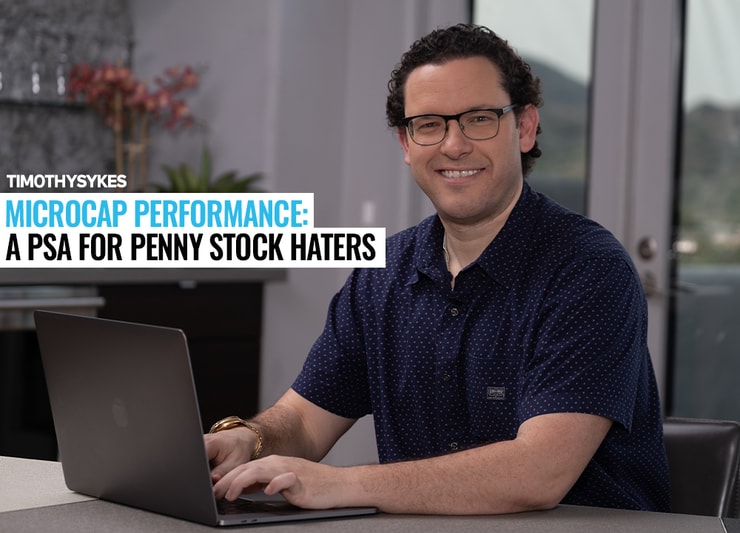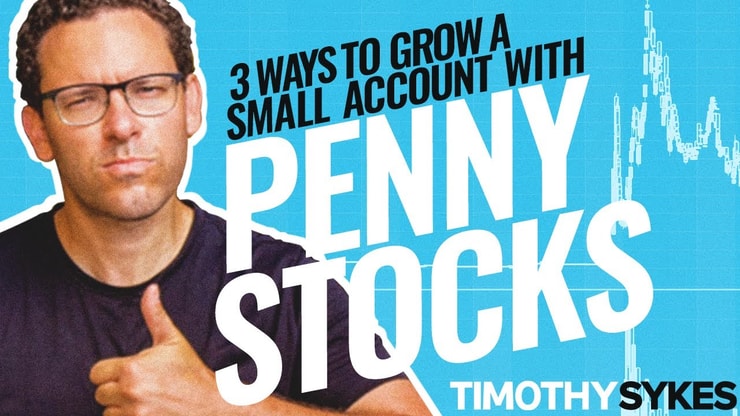Are penny stocks worth it? I think microcap performance speaks for itself…
For the past year, microcap performance has been a lot more impressive than any big-name stocks out there … That creates opportunities for traders.
As of April 2021, I’ve made over $7 million in profits* over the past 20+ years by trading penny stocks — also called microcap stocks due to their tiny market capitalization.
One of my main goals as a teacher is to educate my Trading Challenge students about how penny stocks really work. I want them to learn how to potentially take advantage of the insane price spikes they can experience.
It’s not just a matter of loading up on random low-priced stocks. It’s all about having the right mindset — and having a strategy. Here’s what I want traders to understand about microcap performance…
(*These results are not typical. Individual results will vary. Most traders lose money. I have the benefit of many years of hard work and dedication. Trading is inherently risky. Always do your due diligence and never risk more than you can afford to lose.)
Table of Contents
How Microcap Performance Dominates ‘Real’ Stocks
Here’s a great example of how microcap performance has been dominating the market for the past year.
In case anyone ever says that penny stocks/microcap stocks don't do well, show them this 1-year performance chart of how these major indexes compare…MICROCAPS HAVE DOMINATED $QQQ $SPY $IWM BY FAR! Please retweet/favorite this with your followers so EVERYONE can see the truth! pic.twitter.com/LKmAqBgt7k
— Timothy Sykes (@timothysykes) March 23, 2021
Check out the chart in this blog post…
It details the yearly gains for ETFs representing different segments of the stock market. It shows microcap performance compared to small-cap stocks and large-cap stocks from the Nasdaq and S&P 500.
The data is pretty compelling:
- Microcaps +155.7%
- Small-caps +121.5%
- Nasdaq 100 +89.31%
- S&P 500 +74.64%
Not sure what it all means? Let’s break it down…
Breaking Down Microcap Performance
This data offers a few key takeaways.
First, it demonstrates what an exceptional year it’s been in the stock market. These are some impressive results across the board.
But second, and most importantly … Microcap performance is DOMINATING the market.
To put it in perspective, both the Invesco QQQ Trust and the SPDR S&P 500 ETFs track the top companies from the Nasdaq and S&P 500, respectively.
That includes big-name companies like Amazon.com, Inc. (NASDAQ: AMZN) and Netflix Inc. (NASDAQ: NFLX).
On the other hand, the iShares Micro-Cap ETF and iShares Russell 2000 ETF are tracking small-cap and microcap performance.
On the whole, this data tells us that microcap performance is as much as two times higher than large- or mega-cap performance.
The Trouble With Large-Cap Stocks…
In 2020, the average return for the S&P 500 index was 18.4%.
Don’t get me wrong. That kind of return is great for bigger stocks.
But I’m not patient. Roughly 20% returns might be good for saving for retirement … But they won’t grow a small account quickly.
Microcap performance offers a lot more short-term potential. So why isn’t everyone trading microcaps? Because they don’t understand this crucial thing…
Setting the Record Straight on Microcap Performance
Penny stocks might not make sense to stock market newbies. It’s understandable.
Big investors mostly ignore penny stocks. When they are mentioned in the news, it’s usually in stories about how sketchy and dangerous they are.
This is part of why I teach … I want to cut through the BS. I want to set the record straight on penny stocks.
I also want people to understand the risks that come along with impressive microcap performance.
Despite the amazing potential of penny stocks, I don’t trust these companies as far as I could throw them.
I know — this might sound kind of crazy and counterintuitive. So many stock market lessons are. Let’s make some sense of it…
Making the Most of Microcap Performance
The ‘traditional’ approach to the stock market is to find companies you believe in and invest in them.
That approach doesn’t really work with microcap companies. The thing is, most of them will eventually fail.
That sounds scary at first. Why would you ever put money into a company that’s going to fail?
Penny Stocks Are Not Investment Vehicles
Before penny stocks eventually fail, they can potentially experience huge price spikes in short periods of time.
Think of a big company like Apple Inc. (NASDAQ: AAPL) … It’s like a big freighter stuck in the Suez Canal. It takes a LOT to get it moving.
A penny stock, on the other hand, is like a speedboat. It doesn’t take much to get its motor running. The most dubious of press releases can create huge price spikes.
When the conditions are right, I attempt to ‘ride the wave’ of these types of moves.
I’m not investing in these companies. I’m just trying to take advantage of these short-lived price spikes. My trades are very short term. Sometimes minutes, sometimes hours. Rarely overnight.
More Breaking News
- Oracle’s Surge: Decoding its Stock Movement
- Stock Surge Inquiry: CNR’s Steep Upward Trajectory
- Unexpected Surge: Analyzing Cleveland-Cliffs’ Market Performance
Shift Your Perspective
One of the biggest obstacles to trading penny stocks isn’t the actual process of trading. It’s shifting into a new way of thinking about stocks.
This isn’t investing. It’s not about believing in these companies.
I don’t believe in these companies.
When I’m talking about my trades in my Trading Challenge chat room, in my DVDs, or in my Profit.ly commentary, you might notice that I rarely even mention the names of the companies.
I don’t care what the company names are or what they do — other than to know they’re in a hot sector. But beyond that, they’re all just tickers and potential vehicles for my strategy.
I love hot sectors!!
— Timothy Sykes (@timothysykes) February 13, 2021
History Repeats…
History never repeats exactly. But it’s usually pretty close…
The state of the market right now reminds me a lot of the stock market in 2000.
At the time, I had no idea how exceptional the market conditions were. Microcap performance was incredible then, too … It’s when I made my first million.*
But the high level of potential reward always comes with plenty of risk.
Do yourself a favor — study the past to prepare for what the future could bring.
I talk a LOT about the 2000 market conditions in my autobiography, “An American Hedge Fund” … Check it out to get a better understanding of the risks associated with penny stocks during market conditions like we’re in now.
Mighty Microcap Performance: Be Prepared!
Microcap performance is hotter than ever in 2021. How can traders take advantage of it?
Remember: there are no guarantees in the stock market. Even with the hottest market and potentially biggest bubble in decades, it’s still possible to lose.
Trading is a battlefield. By educating yourself, you’re doing what you can to prepare yourself for battle.
When you understand how penny stocks behave and learn the setups that play out over and over, you’ll have a better understanding of the mechanics of the market. It can help you react from a place of knowledge versus trying to anticipate.
Are you ready to increase your knowledge? Consider applying for my Trading Challenge.
Do you understand the risks and rewards that come with this kind of microcap performance? Leave a comment … I love hearing what you have to say!













Leave a reply